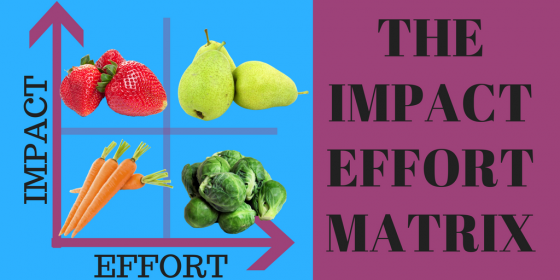I grew up helping my father on the family farm. We grew all manner of fruits and vegetables and then sent them to market or sold them in our own fruit shop. One day I imagine I’ll have a farm of my own but for now I love teaching. One thing that has stuck with me is an obsession with “low hanging fruit”.
The Impact Effort Matrix
Generally I try to give to my blog audience. Today I’m asking you for something. For the next week or so, I want you to consider this.
Am I growing Sweet Strawberries, Pleasing Pears, Common Carrots or Back-Breaking Brussels Sprouts?
Sweet Strawberries
Where I’m from, strawberries are incredibly easy to grow. Generally, when you send them to market, you’ll make quite a bit of money. They’re low-hanging fruit. Strawberries are Low Effort, High Impact
Look for things that you can do that are sweet strawberry quadrant. Low Effort, high Impact.
Examples of Sweet Strawberries
- Saying good morning to your students costs nothing, but building relationships is everything. Low Effort, High Impact.
- Stating Learning Goals at the beginning of a lesson positively affects the learning. Low Effort, High Impact.
- Devising an “exit ticket” strategy is a quick way to get students reflecting on their learning. Low Effort, High Impact.
What sweet strawberries can you pick?
Pleasing Pears
There’s a saying, “grow pears for your heirs”. Pear trees take many years of care before they bear good fruit. But once they do, you have a reliable crop that always fetches a good price.
The Pear quadrant is all about High Effort, High Impact. It will take time but it’s worth it.
Examples of Pleasing Pears
- Lots of teachers in my school are trying “video feedback”. They’ve had to learn how to use new software, deal with computer glitches and marking has taken a little longer. But every teacher agrees that the feedback is the best they’ve ever given. High Effort, High Impact.
- I’ve been flipping my classroom for four years. I had to learn many new skills, make plenty of mistakes and make plenty of videos. But the payoff? Amazing. High Effort, High Impact.
- Find the time to visit another teacher’s classroom and try to learn something new. Or film yourself teaching and watch it back. I know you’re busy, but it’s worth it. High Effort, High Impact.
Common Carrots
Anybody can grow carrots. That’s probably why they’re always so cheap. Low Effort, Low Impact. My father and I didn’t grow many carrots. You shouldn’t either. Stay out of the carrot quadrant.
Examples of Common Carrots
- You’ve been formatting that worksheet for an hour now. Stop, it’s pretty enough! Low Effort, Low Impact.
- Does it really need to be laminated? Are you sure? Stop! Low Effort, Low Impact.
Back-Breaking Brussels Sprouts
I’ll never forget growing brussels sprouts with my father. Head down, bum up, picking those horrible things. The bugs constantly wanted to eat them too. We toiled for hours and in the end we barely made our money back. But we still grew them every year. Perhaps my father felt the effort would one day pay off. It never did. The brussels Sprout quadrant is High Effort, Low Impact. Avoid!
Examples of Back breaking Brussels Sprouts
I think we often, like my father, grow brussels sprouts in schools. The high effort makes it feel important. But please rethink the brussels sprouts.
- Do you really need to collect and mark their homework every day? High Effort, Low Impact.
- Stop rewriting the work program. Do you really need to change the whole thing again? High Effort, Low Impact.
- (For school leaders) Will this PD really make a difference to our student’s learning? Or is it a brussels sprout? High Effort, Low Impact.
What you need to do now.
Hang the Impact Effort matrix above your desk. Every time you look at it ask yourself the question.
Am I growing Strawberries, Pears, Carrots or Brussels Sprouts?
Comment Time
I’d love to hear from you. If you’ve never commented on a blog before, now’s the time! What strawberries and pears should we be growing in our schools and classrooms. What carrots and brussels sprouts are we growing by mistake and should instead avoid?

Brussel sprouts – providing feedback on final assessment pieces by rewriting the criteria sheet! Students can see the boxes you ticked.
Growing strawberries on pairs – Getting students to put together product on line is tiring and time consuming but come the next generation in the next year, they get to reap the rewards and grown strawberries on the pears. Check that for getting some impact from your farm! Heulwen
Well done Joel. Great read. Love the analogies. Hoping I’m picking more strawberries and pears in the future!
Let’s flood the market with strawberries and pears!! Great read Joel & I couldn’t agree more!!!
Agreed. Strawberries also come in the small acts of kindness, thanks and praise that staff do for one another too!
Joel – this is a great blog post. Write a book based on this, you’ll have a massive ed impact and become a millionaire 🙂
Hi Joel, this is great! So timely when we are hoping to reduce teacher workload without reducing the impact we have on learning. Can I use this in my CPD. I obviously will reference yourself.
Absolutely, feel free to use however you wish.
Please come back and let me know how it goes!